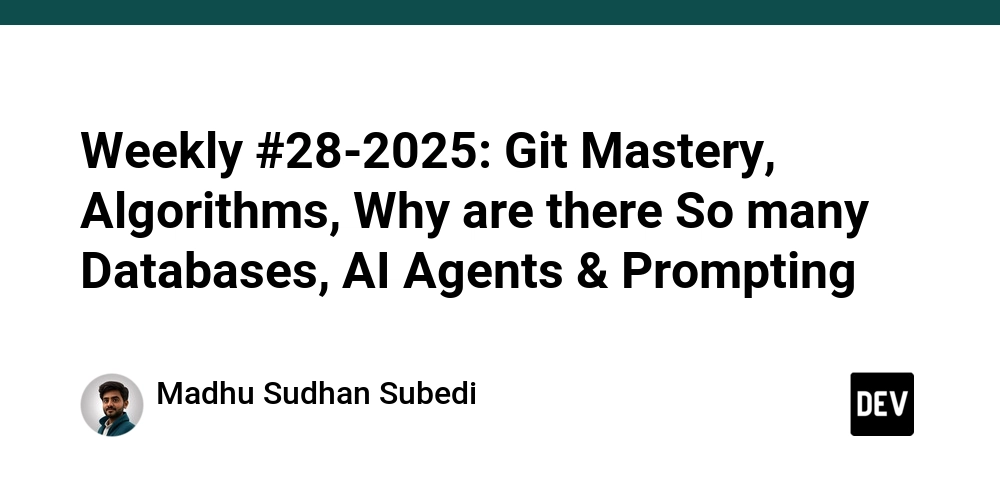Weekly #28-2025: Git Mastery, Algorithms, Why are there So many Databases, AI Agents & Prompting
Madhu Sudhan Subedi Tech Weekly
Git Mastery: 5 Tips to Level Up Your Workflow
Developers, are you ready to become Git power-users? This week, we’re sharing 5 must-know tips to streamline your Git workflow and take your skills to new heights.
First up, learn how to modify your previous commit without changing the commit message – perfect for when you forget that one crucial change. Plus, discover how to keep your commits organized using the git add -p command. And when things go wrong, the git reflog command can take you back to better times before that disastrous commit. Dealing with merge conflicts? Use git checkout –conflict=diff3 to see the base version and make the right call. Finally, enable Git autocorrect to stop those pesky typos from slowing you down. Level up your Git game with these essential tips!
Memory Over Time for Algorithms
Today, I’m talking about a groundbreaking discovery in computer science.
Ryan Williams, a leading computer scientist, has proven something that flips a long-held assumption in the world of algorithms. His research shows that a small amount of memory can actually be more powerful than a large amount of time when it comes to running algorithms.
What does that mean? Basically, he’s come up with a mathematical method to transform any algorithm so it uses much less memory — even if it ends up taking a bit longer to run. This is huge.
Why? Because it challenges the way we’ve traditionally thought about time and space in computing. For decades, time was seen as the more valuable resource. But Williams’ work suggests that space — or memory — might be even more powerful than we believed.
Experts in computational complexity theory are calling this a massive advance. In fact, it’s the first major breakthrough on this problem in over 50 years. And it has left Williams’ colleagues stunned and amazed.
This could open the door to solving some of the biggest, longest-standing problems in computer science.
Why Are There So Many Databases?
The world of databases has changed — big time.
Not long ago, you had just a few options to choose from. But today? There’s a huge variety of databases out there, and it can feel overwhelming. This episode takes you on a quick tour through the modern database landscape, exploring the pros and cons of each type.
So, what’s behind this explosion of options? According to the author, it all comes down to evolving data needs. As problems have become more complex, specialized databases have emerged to solve them — whether it’s for speed, scale, or specific data types.
But with all these choices, a big question comes up: How do you know which one is right for your project?
We’ll dive into the key categories — from data warehouses and data lakes, to transactional databases, and even the newer vector databases powering AI and machine learning. Each has its strengths — and its tradeoffs.
What’s especially interesting is that, despite all the innovation, the author still argues that PostgreSQL — the so-called “boring” choice — might be the best place to start for most applications.
But is that really true? As our data needs keep growing and changing, could the old-school relational database eventually be replaced by newer, more specialized tools?
The future of data management is shaping up to be a fascinating battleground — and we’re just getting started.
MCP vs. API: The Future of AI Agents
Traditional HTTP APIs have long been the standard for web development, but a new protocol called Model Context Protocol (MCP) is challenging the status quo. MCP is designed specifically for AI agents, offering key advantages over traditional APIs.
Unlike APIs, which rely on inconsistent patterns across different endpoints, MCP enforces a standardized structure, making it easier for AI models to interact with servers. MCP also enables bidirectional communication, allowing AI agents to request completions from servers and elicit input from users. Additionally, MCP’s local-first design allows agents to run as standalone processes, inheriting the host’s permissions for direct file access and system-level operations.
As MCP adoption grows, the tech industry may see a shift towards AI-first protocols that provide more reliable and efficient integration between AI agents and backend services. Developers should keep an eye on this emerging protocol and consider how it could impact their AI-powered applications.
Cursor’s Clever Prompting: Unlocks the Power of AI Assistants
Cursor, the AI coding assistant, is turning heads with its remarkably effective prompting system. By precisely defining the AI’s role, personality, and operational constraints, Cursor has managed to create a truly autonomous agent that can tackle coding tasks with impressive autonomy and natural language communication.
The key insights from Cursor’s approach include leveraging XML-like tags to organize complex instructions, granting the AI permission to act independently, and providing practical resource limits. Cursor also cleverly injects custom user rules and dynamic context directly into the prompts, empowering the AI to make informed decisions without constantly asking the user for clarification. These techniques demonstrate how thoughtful prompt engineering can unlock the full potential of large language models, paving the way for more capable and user-friendly AI assistants across various domains.

